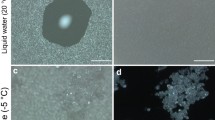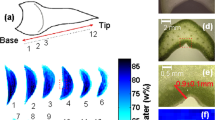Summary
Vitrification of plants in vitro is a physiological abnormality of tissue-cultured plants which causes significant losses in the micropropagation industry. Vitrified plants are waterlogged but the position of water within plants has not been identified. Nuclear magnetic resonance (NMR) imaging of normal tissue-cultured, vitrified tissue-cultured, and glasshouse-grown leaves ofGypsophila paniculata showed the distribution of water within the leaves. Normal tissue-cultured and glasshouse-grown leaves had a high concentration of water within leaf vascular bundles and lower concentrations elsewhere. In contrast, vitrified leaves had a relatively even distribution of high water concentration throughout the leaves. When imaging parameters were changed, so that only water associated with cell membranes was shown, the images of normal tissue-cultured and glasshouse-grown leaves did not change. However, the image of the vitrified leaves showed a general lowering of intensity across the whole of the leaf. The appearance of the NMR images, together with those obtained by light microscopy, suggest that the excess water associated with vitrified plants is located in the intercellular air spaces. The blockage of these spaces may lead to a cycle of perturbations in the plant's physiology culminating in the development of vitrification.
Similar content being viewed by others
Abbreviations
- NMR:
-
nuclear magnetic resonance
References
Borkowska B, Michalczuk L (1987) The physiological disorders of sour cherry cultures: necrosis and vitrification. Acta Hort 212: 235–237
Bottcher I, Zoglauer K, Goring H (1988) Induction and reversion of vitrified plants cultured in vitro. Physiol Plant 72: 560–564
Callaghan PT (1991) Principles of nuclear magnetic resonance microscopy. Clarendon, Oxford
De Fossard R (1976) Tissue culture for plant propagators. Department of Botany, University of New England, Armidale
Debergh PC (1988) Micropropagation of woody species: state of the art on in vitro aspects. Acta Hort 227: 287–295
—, Aitken-Christie J, Cohen D, Grout B, von Arnold S, Zimmerman R, Ziv M (1992) Reconsideration of the term “vitrification” as used in micropropagation. Plant Cell Tissue Organ Cult 30: 135–140
—, Harbaoui Y, Lemeur R (1981) Mass propagation of, globe artichoke (Cynaria scolymus): evaluation of different hypotheses to overcome vitrification with special reference to water potential. Physiol Plant 53: 181–187
Gribble K, Sarafis V, Nailon J, Holford P, Uwins P (1996) Environmental scanning electron microscopy of the surface of normal and vitrified leaves ofGypsophila paniculata (Babies Breath) cultured in vitro. Plant Cell Rep 15: 771–776
Kevers C, Gaspar T (1986) Vitrification of carnation in vitro: changes in water content, extracellular space, air volume, and ion levels. Physiol Veg 24: 647–653
Leshem B (1983) Growth of carnation meristems in vitro: anatomical structure of abnormal plants and the effect of agar concentration in the medium on their formation. Ann Bot 52: 413–415
Loreti F, Pasqualetto PL (1987) Vitrification of plants cultured in vitro. In: Hartmann HT (ed) International Plant Propagators Society combined proceedings of annual meetings, vol 36. International Plant Propagators Society, University of Washington, Seattle, pp 66–71
McCain DC, Markley JL (1992) A nuclear magnetic resonance imaging technique designed for studies of water in leaves. J Struct Biol 108: 195–201
Paques M, Boxus P (1987) Vitrification: a phenomenon related to tissue water content. Acta Hort 212: 245–252
Pope JM (1992) Applications of chemical shift microscopy to non-invasive histochemistry of plant materials. In: Blumich B, Kuhn W (eds) Magnetic resonance microscopy. VCH, Weinheim, pp 441–457
—, Jonas D, Walker RR (1993) Applications of NMR micro-imaging to the study of water, lipid and carbohydrate distribution in grape berries. Protoplasma 173: 177–186
Raven JA (1996) Into the voids: the distribution, function, development and maintenance of gas spaces in plants. Ann Bot 78: 137–142
—, Handley LL, McInroy S, McKenzie L, Richards JH, Samuelsson G (1988) The role of CO2 uptake and CAM in inorganic C acquisition by plants of the isoetid life form: a review with new data onEriocaulon decangulare. New Phytol 108: 125–148
Werker E, Leshem B (1987) Structural changes during vitrification of carnation plantlets. Ann Bot 59: 377–385
Williamson B, Goodman BA, Chudek JA (1992) Nuclear magnetic resonance (NMR) micro-imaging of ripening red raspberry fruits. New Phytol 120: 21–28
Woolley JT (1983) Maintenance of air in intercellular spaces of plants. Plant Physiol 72: 989–991
Xia Y, Sarafis V, Campbell EO, Callaghan PT (1993) Non-invasive imaging of water flow in plants by NMR microscopy. Protoplasma 173: 170–176
Ziv M (1991) Quality of micropropagated plants: vitrification. In Vitro Cell Dev Biol 27P: 64–69
Author information
Authors and Affiliations
Rights and permissions
About this article
Cite this article
Gribble, K., Tingle, J., Sarafis, V. et al. Position of water in vitrified plants visualised by NMR imaging. Protoplasma 201, 110–114 (1998). https://doi.org/10.1007/BF01280717
Received:
Accepted:
Issue Date:
DOI: https://doi.org/10.1007/BF01280717




